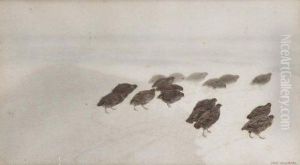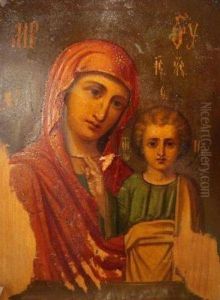Jozef Chelmonsky Paintings
Józef Chełmoński was a Polish painter known for his unique style and depiction of the Polish countryside, its wildlife, and the peasant life. He was born on November 7, 1849, in Boczki near Łowicz in Congress Poland under the rule of the Russian Empire. Chełmoński came from a patriotic Polish family, which had a significant influence on his future artistic path.
In 1867, Chełmoński began his formal art education at the Warsaw School of Drawing, which was quickly followed by his studies at the renowned Academy of Fine Arts in Munich in 1871. The Munich Academy was a leading center for art at the time, and it played a crucial role in shaping Chełmoński's skills and style. It was here that he was exposed to the techniques of the Munich School, which emphasized realism and attention to detail.
Chełmoński's early work often focused on historical and military subjects, but he soon found his true calling in the landscapes and rural life of his homeland. His works are characterized by a realistic representation of nature and a fascination with the changing seasons, weather conditions, and times of day. One of his most famous paintings, 'Storks' (1871), depicts a group of storks against the backdrop of a stormy sky, showcasing his ability to capture the mood and atmosphere of a scene.
After spending some time in Paris in the 1870s, where he was influenced by the French Realist movement, Chełmoński returned to Poland and settled in the village of Kuklówka. His paintings from this period are marked by a deep love and respect for the Polish landscape and rural life, which he portrayed with a sense of dignity and an almost poetic sensibility.
Chełmoński's work was well-received in his lifetime, and he was awarded numerous medals and honors. Despite his success, he led a solitary life and often struggled financially. His later years were marked by poor health, and he died on April 6, 1914, in Kuklówka. Chełmoński's legacy lives on, and he is celebrated as one of Poland's most important and influential Realist painters, whose work continues to be admired for its powerful representation of the Polish landscape and its people.

